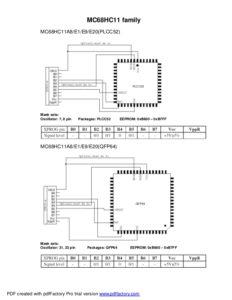Replicate MC68HC11A8 MCU Memory Program
The crystal oscillator circuit consists of an inverting amplifier and an external crystal. The OSC1 pin is the input to the amplifier and the OSC2 pin is the output. The SIMOSCEN signal from the system integration module (SIM) enables the crystal oscillator circuit from Replicate MC68HC11A8 MCU Memory Program.
The CGMXCLK signal is the output of the crystal oscillator circuit and runs at a rate equal to the crystal frequency. CGMXCLK is then buffered to produce CGMRCLK, the PLL reference clock.
CGMXCLK can be used by other modules which require precise timing for operation when Duplicate MC68HC11K1 MCU Locked Program. The duty cycle of CGMXCLK is not guaranteed to be 50% and depends on external factors, including the crystal and related external components.
An externally generated clock can also feed the OSC1 pin of the crystal oscillator circuit. For this configuration, the external clock should be connected to the OSC1 pin and the OSC2 pin allowed to float.
The PLL is a frequency generator that can operate in either acquisition mode or tracking mode, depending on the accuracy of the output frequency to carry on MCU extraction. The PLL can change between acquisition and tracking modes either automatically or manually.
The PLL consists of the following circuits:
- Voltage-controlled oscillator (VCO)
- Modulo VCO frequency divider
- Phase detector
- Loop filter
- Lock detector
The operating range of the VCO is programmable for a wide range of frequencies and for maximum immunity to external noise, including supply and CGMXFC noise. The VCO frequency is bound to a range from roughly one-half to twice the center-of-range frequency, fVRS when Unlock MC68HC11K4 Microcontroller Eeprom Memory.
Modulating the voltage on the CGMXFC pin changes the frequency within this range. By design, fVRS is equal to the nominal center-of-range frequency, fNOM, (4.9152MHz) times a linear factor L, or (L) fNOM.


